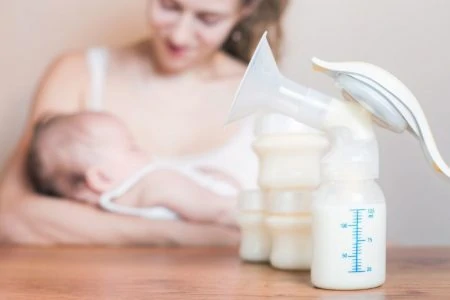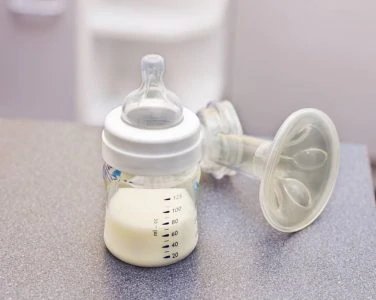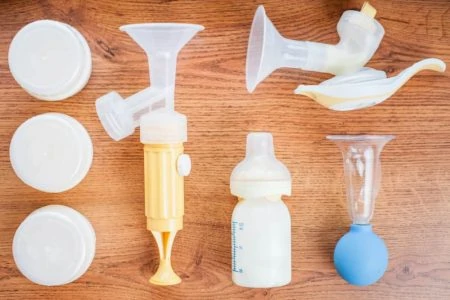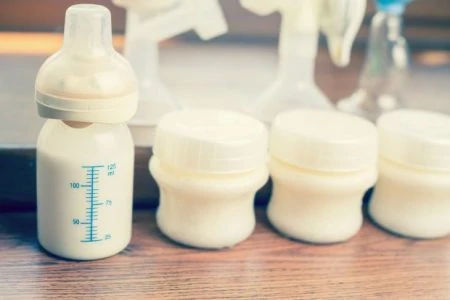Have you been exploring options for preventing pregnancy while breastfeeding? Are you concerned some types of birth control might not be safe for your baby?
Join the club — many women are unsure which birth control methods are safe or recommended after their baby is born.
By educating yourself on the do’s and don’ts of birth control, breastfeeding, and planning for your future, you can take control over your body and find a perfect option that fits you!
Key Takeaways
- Breastfeeding can be a natural birth control method called Lactational Amenorrhea (LAM), but only if certain conditions are met: no returned periods, exclusive breastfeeding, and baby is under 6 months old.
- You can still get pregnant while breastfeeding, especially if your periods have returned or breastfeeding routine changes.
- Progestin-only birth control pills, IUDs, and Nexplanon Implants are safe and effective options for breastfeeding moms, but remember to consult with your doctor.
- To ensure a healthy recovery and minimize risks, experts recommend waiting at least 18 months between pregnancies.
- Is Breastfeeding a Reliable Form of Birth Control?
- Using Breastfeeding as Birth Control
- Disadvantages of Breastfeeding as Birth Control
- Can You Get Pregnant While Breastfeeding?
- Is Birth Control Safe While Breastfeeding?
- Birth Control Pills and Milk Supply
- How Does Progestin Work?
- Using Birth Control After Birth
- Birth Control Options While Breastfeeding
- Morning-After Pills and Milk Supply
- When Can I Get Pregnant Again?
- FAQs
- The Bottom Line
Is Breastfeeding a Reliable Form of Birth Control?
Breastfeeding can be a reliable form of birth control, but there is a special way to go about the process to prevent pregnancy naturally. Lactational Amenorrhea, otherwise referred to as LAM, is the method of using breastfeeding as a natural form of birth control.
Breastfeeding exclusively — without offering formula supplements, starting solids, or pumping — tells your body you need to focus on your new baby and nothing else. This should prevent you from ovulating, making another pregnancy highly improbable during this period.
However, three conditions need to be true for LAM to prevent pregnancy (1):
- Your periods have not returned.
- You are breastfeeding without supplementing, and your baby is feeding often.
- Your baby is younger than 6 months.
If you can say yes to all three of these conditions, then LAM is as effective as other forms of birth control. As soon as any of the answers change to no, you need to use a backup form of birth control.
Using Breastfeeding as Birth Control
As long as you keep up with frequent feedings and don’t go more than four to six hours without your baby on the breast, your chances of getting pregnant will be reduced. However, there’s always more you can do to maximize this natural infertility stage.
Here are a few ways to make breastfeeding as your birth control more reliable:
- Avoid pacifiers: By encouraging your baby to turn to you for comfort when they need to suck, you make your body more receptive to their needs, and you keep your hormones at a level that will inhibit ovulation.
- Breastfeed at night: This one is extremely important to maintaining the efficiency of breastfeeding as birth control. The more time you spend nursing, the more protected you’ll be.
Disadvantages of Breastfeeding as Birth Control
Moms and experts agree that breastfeeding is amazing! It kick-starts your little one’s life with all the nutrients they need, helps your body recover faster from the birthing process, and can even prevent pregnancy.
Since it’s a cost-free option and is something you’re already doing, it might seem like an obvious choice. With all the great things breastfeeding does, it’s hard to imagine it could come with any disadvantages.
However, you must be very precise if you choose to breastfeed as your main birth control option. The best way to ensure its effectiveness is to use diligence and consistency. Missing too many feedings in a short period can increase your pregnancy risk.
Tired moms facing struggles in their breastfeeding journey may not be able to nurse often enough to make the LAM method effective.
Many women choose to begin pumping or supplement with formula — whether for medical reasons or personal choice. This makes breastfeeding ineffective as birth control.
As we mentioned — if you aren’t breastfeeding exclusively every 4 to 6 hours, you’re losing reliability. And once you become sexually active again and resume regular periods, you’ll need to switch to another form of birth control (2).
Additionally, nursing to prevent pregnancy will only be effective for about six months. Once your baby starts nursing less frequently and moves on to their first solid food, it’s time to look into another birth control method.
Breastfeeding naturally suppresses your estrogen levels, which can lead to decreased libido and vaginal dryness, making sex not as comfortable as you’d like. A water-based lubricant can help. As far as ramping up your sex drive, that may just take time.
Find other ways to be intimate, and be open with your partner about the changes you’re experiencing. It may just be that you feel “touched out” after having a baby attached to you all the time. Or maybe your baby’s 24/7 needs leave you feeling too tired for intimacy. These changes are normal and temporary.
Editor's Note:
Michelle Roth, BA, IBCLCCan You Get Pregnant While Breastfeeding?
You can absolutely get pregnant while you’re still breastfeeding because your fertility can return, even if you breastfeed a lot. All it takes is a sudden change in your breastfeeding routine to kick-start the baby-making hormones.
As soon as your periods have returned to their usual routine, it’s safe to assume you are fertile and can conceive.
Another concern breastfeeding moms often have is whether breastfeeding will affect their pregnancy tests. Once again, you don’t have to worry. A pregnancy test will only pick up the hormones released in the event of a pregnancy. Breastfeeding won’t interfere with these hormones or alter the results of a pregnancy i
They can detect the difference between old hormones from your last pregnancy and those released when a new life begins.
If you’re trying to get pregnant while breastfeeding a toddler and still struggling, it may be time to introduce more solid foods and have your baby spend less time at the breast. This will help your hormones return to normal, making it easier to host an egg and allow for fertilization.
Is Birth Control Safe While Breastfeeding?
The short answer? Yes! Many birth control methods, including implants, are safe for use during breastfeeding and won’t hurt you or your baby. Learning about the advantages of each method of birth control can help you decide which one to choose.
With the hustle and bustle that comes with raising a baby, you might not have thought of pregnancy prevention yet. You’re in the middle of the newborn stage, recovering from birth, and just trying to figure out your new daily routine.
The last thing you’ve even started to worry about is doing it all again! And sex may be the furthest thing from your mind.
Even so, birth control after pregnancy is critical. We don’t stop being fertile just because we finally have a baby in our arms. It’s important to stay on top of pregnancy prevention.
Birth Control Pills and Milk Supply
Birth control pills containing hormones are popular because of their effectiveness and simplicity. They’re easy to start, easy to stop, and perfect for a low-stress, low-cost way to avoid pregnancy.
However, the estrogen in these pills may make it harder to produce milk for your baby. Many birth control pills contain both estrogen and progestin, so make sure you ask your doctor for ones that only include progestin if you’re planning to breastfeed (3).
It takes around six weeks for your milk supply to settle in to match your baby’s needs perfectly, and some doctors may feel comfortable prescribing a birth control method that contains estrogen around that time.
Discuss alternatives with your doctor if you want to begin birth control sooner than six weeks postpartum.
How Does Progestin Work?
Progestin increases the amount and thickness of the mucus in your vagina, making it impossible for sperm to pass through. If no sperm can reach your eggs, you can’t get pregnant. It also helps your body skip releasing an egg during ovulation.
In the case of progestin birth control pills, you do have regular periods. However, you won’t be able to get pregnant because of the physical changes it causes in your body.
Using Birth Control After Birth
Since doctors strongly recommend women wait at least six weeks after giving birth before having sex, you don’t need to begin any birth control medication until about a month after birth. This gives your body time to recover and prepare for another hormonal change to be introduced.
Breastfeeding immediately begins acting as birth control from the first time your baby latches, so if this is the path you’re taking, you don’t have to worry about doing anything different once you resume regular sexual activity.
If you choose to begin another birth control method, it’s a good idea to start using it shortly before you think you’ll be sexually active again.
Birth control pills take about seven days to become active in their protection against pregnancy, so plan ahead with your partner if you don’t trust nursing as your only method. Other options like implants are often suggested at the six-week postpartum checkup.
Talk to your doctor around this time to decide what’s best.
Safety First
Birth Control Options While Breastfeeding
There are many birth control options available. Every option has advantages and disadvantages. These are some of the best choices for breastfeeding moms:
1. IUD
Many women opt for an intrauterine device — also known as an IUD. IUD s are considered by many to be the most effective form of birth control. One type contains absolutely no hormones and is instead made of copper, which intervenes with the sperm’s ability to reach the uterus.
Another type of IUD is made with progestin levels so low they likely won’t affect your milk supply, especially if placed after six weeks. However, there is a small risk that your milk supply can be decreased, just as with the pill. IUDs are safe for breastfeeding women and are over 99% effective (4).
The period of time your IUD lasts will depend on which type you choose. You’ll be protected for up to three to five years if you use the progestin kind or up to 10 years with copper IUD. You can have it removed if you decide you want to expand your family before that time runs out.
2. Nexplanon Implant
Though this is another option where a device is inserted into the body, this birth control implant is much less invasive than the IUD. A small rod — about the size of a matchstick — is placed in your upper arm. It releases progestin into your body to prevent pregnancy from occurring.
Again, since this option only uses progestin, most women don’t see any impact on their milk supply (though the theoretical risk still exists). The only risk that the Nexplanon implant presents is a slight chance for infection since it is a foreign object being placed into the body.
The success rate with the birth control implant is the same as the IUD, and these two see higher results because of their simplicity to use. You don’t have to remember to do anything special like take your pills because the device does the work for you. However, if your milk supply is impacted, it is more difficult to remove an IUD than stop taking a pill.
3. Progestin Birth Control Pills
Since it’s important for breastfeeding moms to avoid estrogen, scientists have created the “mini-pill.” The mini-pill is a form of birth control that only contains progestin and works just as well as combination pills.
Taking oral contraceptives comes with a bit of a risk, especially for distracted new moms. They’re only effective if taken correctly and consistently every time. Each missed or delayed dose puts you at further risk for pregnancy, so the 99% success rate is based only on methodical habits.
This method is widely enjoyed because it’s the easiest to start and stop using. Plus, it comes with zero risks for infection since you don’t have to insert anything. You can also use birth control to regulate your cycle, so you’ll experience less cramping and more consistent flow activity during your period.
While the research about progestin-only pills’ impact on milk supply is contradictory, if you notice that your milk supply is affected once you start the mini-pill, you can always stop and use a backup form of birth control.
Editor's Note:
Michelle Roth, BA, IBCLCMorning-After Pills and Milk Supply
Like birth control pills, the morning-after pill comes in two different types. One contains progestin, and the other is a combination pill with both hormones you’d find in name-brand oral contraceptives.
If you take the progestin-only pill, you won’t see a difference in how your body produces milk for your baby.
If your only option is the combination morning-after pill, you may get away without a single change in milk production. For women who aren’t so lucky, the negative effect on your supply should only last a day or two at most (5).
Take Note
When Can I Get Pregnant Again?
After my son was born, I thought I’d never want to go through the exhaustion of birth, newborns, and breastfeeding again. To my surprise, it wasn’t long before I started thinking back fondly to my pregnancy memories. I was ready to do it all again sooner than I ever imagined.
Most obstetricians and midwives recommend waiting six weeks before resuming intercourse. This gives your body time to heal. Even then, you may not be interested in sex. On the other hand, some women feel great after birth and want to resume their relationship sooner.
Editor's Note:
Michelle Roth, BA, IBCLCYou shouldn’t be too eager to jump back into maternity clothes, though. Experts recommend waiting 18 months between pregnancies. The shorter the time between pregnancies, the higher the chances are for premature birth and other problems.
Your body needs adequate time to recover. Getting pregnant too soon after giving birth will create potential risks and stress on your body. So finding a reliable and safe birth control method is so important for you and your future children.
FAQs
The Bottom Line
Choosing the safest and most effective method of birth control for you is an essential postpartum step. It’s a choice that can be made by every mom as soon as her sexual activity resumes.
You have plenty of options to choose from. If you have any questions or concerns about birth control and breastfeeding, discuss them with your doctor.










